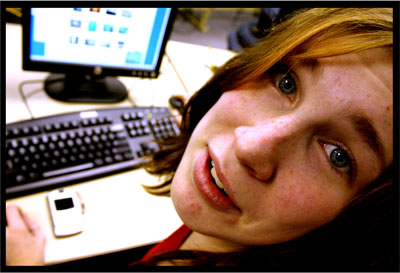All Nonfiction
- Bullying
- Books
- Academic
- Author Interviews
- Celebrity interviews
- College Articles
- College Essays
- Educator of the Year
- Heroes
- Interviews
- Memoir
- Personal Experience
- Sports
- Travel & Culture
All Opinions
- Bullying
- Current Events / Politics
- Discrimination
- Drugs / Alcohol / Smoking
- Entertainment / Celebrities
- Environment
- Love / Relationships
- Movies / Music / TV
- Pop Culture / Trends
- School / College
- Social Issues / Civics
- Spirituality / Religion
- Sports / Hobbies
All Hot Topics
- Bullying
- Community Service
- Environment
- Health
- Letters to the Editor
- Pride & Prejudice
- What Matters
- Back
Summer Guide
- Program Links
- Program Reviews
- Back
College Guide
- College Links
- College Reviews
- College Essays
- College Articles
- Back
Education Revolution (REVISED)
Yes, in my opinion it's true, education has our minds stunted. It doesn't make much sense that something meant to open our minds to the possibilities of the world around us has such a negative effect on the youth of this generation. Why then, is it the truth? Well, simple. Restrictions, measuring the ability of growth and learning by restricting the environment in which it can do so. The world to us is a picture in a textbook, a map on a marker board, memorization and sitting in hard, cold chairs for far too long, change needs to come to the world we live in. Yet, we students are not the ones that have the say in it. Instead some distant adults vote on what we will learn, what we will do, where we can go-even if we can go! So we are jailed in a drab, cold building for seven hours a day, sitting for most of the time. I believe that there are a few major as well as subtle changes that can be made to truly improve not only the quality of our education but the appreciation of it as well.
The first thing I would change, if given the power and opportunity, would be the method used for testing. The typical standardized test is a strict and traditional way of testing. Who said that using number two pencils,filling in bubbles, and giving short answers is the only way to test if a student has really learned the material? Personally, I am a good tester. However, I hurriedly shove the material into my brain within the span of a few days, then the information is lost among whatever lesson I am learning next. Testing the way the state requires is restricting our learning capacity by not actively engaging our minds throughout the testing experience. There's always one way to do everything and if you don't know how to do it, well, too bad, you fail. What if instead of tests having one question, one way to figuring out an answer to that question, and having one answer:we had a question, had a world of ways to figure out how to answer it, and then had the answer? What if during a test we could ask questions? What if we were able to get out and actively seek our answer? Also, the things we are taught in class revolve around state testing. In other words, we are being taught to test but the tests are still far from what we learn in class. One example of this is the way I have been taught science vs. the way I was tested over it. I love science, I enjoy working in a laboratory situation, I am intrigued when I see a result forming from the actions I am doing. Observing, experimenting, learning from my mistakes--that is what I love about science. So, I thought that I would delight in taking the science portion of the ACT. However, when I heard that not-so-enthusiastic voice say “Okay, you may begin.”. All I saw on that test were charts, diagrams, symbols I've never seen before, and only a few words in long paragraphs I could even briefly relate to something I've done in class. I wanted to see things I had used, things I had done! I feel that if I were given a lab to complete and a report to write on it, I would have washed that test away. But when I was taking that ACT, I felt like my mind had closed in on me and all my thinking was inferior to those words and bubbles. Making a change from a undynamic way of testing to an active way of testing brings me to my second point of action, more hands-on learning in all the classrooms.
In education lingo, hands-on learning is called PBL, which stands for Project Based Learning. Our classrooms today are full of lectures and note-taking. When teachers ask us questions, we raise our hands and give the textbook answer so that they will put a lovely “participates in class discussion” on our grade card. However, our minds get bored with memorization and mundane repetition. I'm not in any way saying that we should throw away these more traditional ways of learning. I am only suggesting that we have much less of them. The state of Ohio requires that students have 120 hours of non-lab seat time a year and then another 150 hours for lab classes. This means that our school system is giving us 120 hours of hands-off learning! However, when it comes to field trips for any given class, the state does allow those hours to count as “seat time.” So why is it that we aren't using field trips for more experience? I believe that we students can be lectured all the state wants us to be, but the only true way to learn what they are telling us is by doing it. Now, one might say there are certain subjects that can't necessarily be done. History, for example, isn't one you would think of right off to be experienced. Yet, I think a student may be more able to recall what happened when taking a test if acting out the moment in history with classmates or seeing where it had taken place rather than simply hearing about it. I myself learn so much better this way, just this last June was proof of that. I had decided that I would go to Haiti with a group of optometrists at my church. The objective was to prepare to take eye exams, write accuaties, prescribe medications, and find the correct glasses to give to the patient. We were to go to meetings at 8:00 am on Sundays and listen to the doctors try to teach us all the information we needed to know. I did my best at listening, but I was so excited over the idea of another country that I could recall little of all the medical content they had discussed. Of course, the first day I did eye clinics in Haiti, I panicked. However, I had retained a bit of information, and I was able to ask questions on scene. It was not only a learning experience, but an enjoyable one. I believe that this philosophy can apply to learning in schools. It would force us to learn in a very intriguing, thoughtful way.
Not all of the changes to our education system need to be large in scale. I think there are some rather small changes that our school could make to stimulate the mind and enhance learning in a creative way. Stimulus in the brain can be enhanced by many things in the environment around us. The way our school's environment is set up does not in any way have stimulating characteristics. The walls are a bleak gray, deep red or dark blue, the lights are a harsh fluorescent, and it is kept cold and uncomfortable. Many would say that these things are to keep us awake, alert and focused. I know for a fact that the walls are gray in the high school wing because of our school colors and coding system (elementary wing, high school wing etc.). What some might not know is that this may be actually harming our education. In a psychological perspective, gray is the color of non-commitment. In the brain it stimulates feelings of separation, lack of involvement, and loneliness. A very deep red raises blood pressure and entices feelings of anger and frustration. While a dark blue is shown to bring on sleepiness, because of the way our brains relate this color to nighttime. Instead it would be a more knowledgeable choice to pick colors like orange, yellow, and purple. All these colors inspire creativity, attentiveness, memory, clear thinking, and other positive aspects (“Psychology:Colors”). The fluorescent lights may also be attributing to our state of well-being and therefore stealing from our full potential. Scientifically, fluorescent lights have been proven to have a negative affect on the body. “The imbalance of frequencies in fluorescent lighting has the same adverse effect on people as an imbalance of nutrients,” (“Fluorescent Dangers”). Symptoms that accompany exposure to fluorescent lights are as follows: dizziness, headaches, blurred vision, eye strain, skin rashes, sinus problems, fatigue, nausea, sleep disturbances, mood swings, and irritability. My proposed solution would be to replace these lights with full-spectrum lights. Studies done by John Ott, a photobiologist, have shown that when fluorescent lighting is replaced with full-spectrum lighting, attendance and behavior improve significantly in the classroom (“Fluorescent Dangers”). As for the cold, well, a simple solution would be to tone down the air conditioning just slightly. An unbearably uncomfortable student doesn't make for a very focused one.
Yet, all of these environmental aspects haven't always been so disconcerting. When I was in elementary school our walls were yellow, we were always moving and learning--we did something new and exciting every day. In history we built castles, in English we wrote our own version of The Wizard of Oz, in Math we had pi day (involving delicious pie and fun beads). Why is it that people have the idea that only younger kids can learn that way? So, the material may be more advanced but that doesn't mean we can't learn it in an exciting environment.
Exciting, fun, intriguing, interesting, compelling, inspiring--all of these terms could be the words that future generations might put in their poetry about school! I believe that all these changes could allow education in the state of Ohio, as well as the United States, to excel farther than anyone could have imagined. They could re-shape the idea teenagers like myself have of school altogether, allowing future generations to love the way they learn.

Similar Articles
JOIN THE DISCUSSION
This article has 0 comments.
